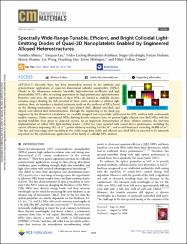Spectrally Wide-Range-Tunable, Efficient, and Bright Colloidal Light-Emitting Diodes of Quasi-2D Nanoplatelets Enabled by Engineered Alloyed Heterostructures

Göster/
Erişim
info:eu-repo/semantics/openAccessTarih
2020Yazar
Altintas, YemlihaLiu, Baiquan
Hernandez-Martinez, Pedro Ludwig
Gheshlaghi, Negar
Shabani, Farzan
Sharma, Manoj
Wang, Lin
Sun, Handong
Mutlugun, Evren
Demir, Hilmi Volkan
Üst veri
Tüm öğe kaydını gösterÖzet
Recently, there has been tremendous interest in the synthesis and optoelectronic applications of quasi-two-dimensional colloidal nanoplatelets (NPLs). Thanks to the ultranarrow emission linewidth, high-extinction coefficient, and high photostability, NPLs offer an exciting opportunity for high-performance optoelectronics. However, until now, the applications of these NPLs are limited to available discrete emission ranges, limiting the full potential of these exotic materials as efficient light emitters. Here, we introduce a detailed systematic study on the synthesis of NPLs based on the alloying mechanisms in core/shell, core/alloyed shell, alloyed core/shell, and alloyed core/alloyed shell heterostructures. Through the engineering of the band gap supported by the theoretical calculations, we carefully designed and successfully synthesized the NPL emitters with continuously tunable emission. Unlike conventional NPLs showing discrete emission, here, we present highly efficient core/shell NPLs with fine spectral tunability from green to deep-red spectra. As an important demonstration of these efficient emitters, the first-time implementation of yellow NPL light-emitting diodes (LEDs) has been reported with record device performance, including the current efficiency surpassing 18.2 cd A(-1), power efficiency reaching 14.8 lm W-1, and record luminance exceeding 46 900 cd m(-2). This fine and wide-range color tunability in the visible range from stable and efficient core/shell NPLs is expected to be extremely important for the optoelectronic applications of the family of colloidal NPL emitters.

















